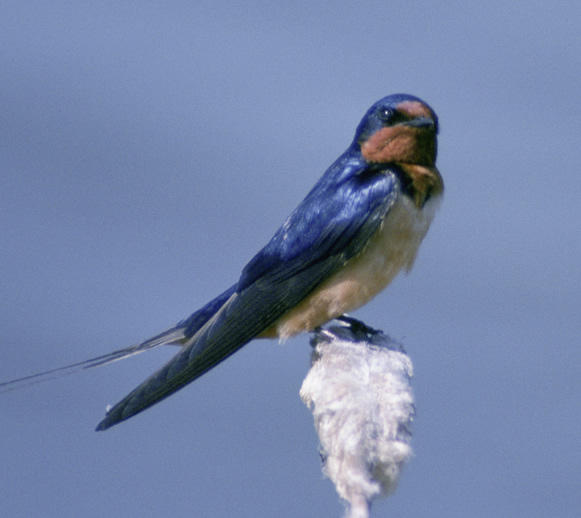However this past May, the Vancouver Sun newspaper interviewed Bridget Scutchbury a professor of biology at Toronto’s York University. Scutchbury has written a book titled Silence of the Songbirds. She tells us that “a disappropriate number of songbirds are on the decline”.
“There have been increases in some bird populations – for example, some species that can adapt well to urban or suburban environments are doing okay because of the increase in those environments. But by following the data from breeding bird surveys, which have been taken annually since the mid-1960’s, shows at least 28 species of migratory songbirds are in significant decline.”
According to Scutchbury the news is not good for the Barn Swallow either.
“Barn Swallows are in tremendous decline. It’s one of those mystery birds because we really don’t know what’s going on with them. I mean, they live anywhere – in urban or suburban areas. So why are they crashing? I wouldn’t be surprised if it didn’t have something to do with pesticide poisoning.”
This spring a new analysis by the National Audubon Society revealed that populations of some of North America’s most familiar common birds have been in decline for the past forty years, with some down as much as 80 percent. The dramatic declines are attributed to the loss of grasslands, healthy forests and wetlands, and other critical habitats from multiple environmental threats such as urban sprawl, energy development, and the spread of industrialized agriculture.
The study notes that these threats are now compounded by new and broader problems including the escalating effects of global warming. In concert, they paint a challenging picture for the future of many common species and send a serious warning about our increasing toll on local habitats and the environment itself.
“These are not rare or exotic birds we’re talking about—these are the birds that visit our feeders and congregate at nearby lakes and seashores and yet they are disappearing day by day,” said Audubon Chairperson and former EPA Administrator, Carol Browner.
“Their decline tells us we have serious work to do, from protecting local habitats to addressing the huge threats from global warming.”
Species on Audubon’s list of 20 Common Birds in Decline have seen their populations plummet at least 54 percent since 1967. The following are among those hardest hit:
Northern Bobwhite populations are down 82 percent and have largely vanished from northern parts of their range in Wisconsin, Michigan, New York and New England mainly due to loss of suitable habitat to development, agricultural expansion and plantation-style forestry practices.
Evening Grosbeaks that range from mountains of the west to northern portions of the east coast show population declines of nearly 78 percent amid increasing habitat damage and loss from logging, mining, drilling and development.
Northern Pintail populations in the continental U.S. are down nearly 78 percent due to expanding agricultural activity in their prairie pothole breeding grounds.
Greater Scaup populations that breed in Alaska, but winter in the Great Lakes and along Atlantic to Pacific Coasts are being hard hit by global warming induced melting of permafrost and invasion of formerly-southern species; populations are down approximately 75 percent.
Eastern Meadowlarks, down 71 percent, are declining as grasslands are lost to industrialized agricultural practices. Increased demand for biofuel crops threatens increased agricultural use of lands that are currently protected, making both Eastern and Western Meadowlarks even more vulnerable.
Common Terns, which nest on islands and forage for fish near ocean coasts, lakes and rivers, are vulnerable to development, pollution and sea level rise from global warming. Populations in unmanaged colonies have dropped as much as 70 percent, making the species’ outlook increasingly dependent on targeted conservation efforts.
Snow Buntings, which breed in Alaska and northern Canada, are suffering from the loss of fragile tundra habitat as global warming alters and disrupts the Arctic’s delicate ecological balance; populations are down 64 percent.
Rufous Hummingbird populations have declined 58 percent as a result of the loss of forest habitat to logging and development, in both their breeding range in the Pacific Northwest and their wintering sites in Mexico.
Whip-poor-wills, down 57 percent, are vulnerable to fragmentation and alteration of their forest habitat from development and poor forest management practices.
Little Blue Herons now number 150,000 in the U.S. and 110,000 in Mexico, down 54 percent in the U.S. Their decline is driven by wetland loss from development and degradation of water quality, which limits their food supply.
Overall, agricultural and development pressures have driven grassland birds to some of the worst declines, followed closely by shrub, wetland and forest-dependent species.
“Direct habitat loss continues to be a leading cause for concern,” said Audubon Bird Conservation Director and analysis author, Greg Butcher, PhD. “But now we’re seeing the added impact of large-scale environmental problems and policies.”
Butcher notes that global warming is damaging some key habitats and speeding the spread of invasive species that spur further declines. Mounting demand for corn-based ethanol fuels is expected to result in increased use of marginal farmland that currently serves as important habitat. The fate of species such as Eastern Meadowlarks and Loggerhead Shrikes could hinge on efforts to conserve these areas.
“People who care about the birds and about human quality of life need to get involved in habitat protection at home, in pushing for better state and national protections and in making changes in their daily routines,” Butcher adds.
According to Prof. Bridget Scutchbury, “the small changes we make in our homes do add up”.
“The good news is, none of the songbird species are actually (classified as) endangered species yet, though they may be in 40-50 years. There may still be time to save them.”
(30)



